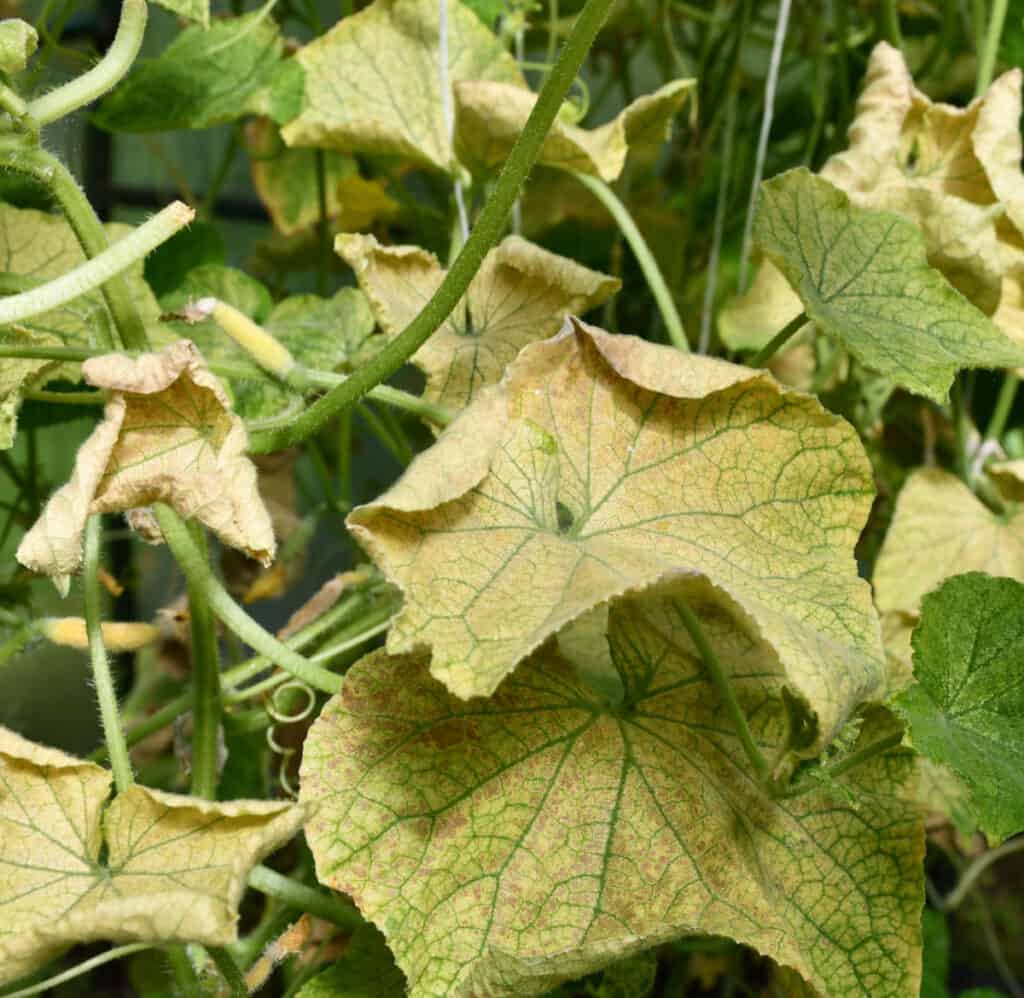Cucumber leaves turn yellow due to nutrient deficiencies, pests, or overwatering. Identifying the cause helps in treatment and prevention.
Cucumbers are the most common plants you can grow in your backyard. They have a variety of species which are more beneficial to gardeners. Those types include bush, slicing, and vining cucumbers. Slicing cucumbers are super larger and longer. Although cucumber is the most beneficial plant, sometimes growing it comes with challenges from the day of planting up to maturity (especially if you’re clueless on how to care about those plants) fortunately, the leaves of cucumbers act as reporters. When something takes place in your cucumber plant, leaves are the first to alarm you. You can notice cucumber leaves turning yellow or wilt.
Yellowing cucumber leaves can be concerning for gardeners. This issue often stems from a lack of essential nutrients like nitrogen or magnesium. Pests such as aphids or spider mites may also be the culprits. Overwatering or poor drainage can lead to root rot, causing the leaves to turn yellow.
Ensuring proper watering practices and maintaining soil health are crucial. Regularly inspecting plants for pests and signs of nutrient deficiencies can prevent yellowing. Addressing these issues promptly ensures healthy cucumber plants and a bountiful harvest. Follow these steps to keep your plants vibrant and productive.
So the primary gist of this post is to identify why cucumber leaves turning yellow. We’ve researched and compiled everything you should understand about changing the colour of your cucumber plants.

General Functions of Leaves
Leaves are not just flattened organs of vascular plants that shoot from the stem of a plant. Their primary function is generally photosynthesis and gas exchange. Gas exchange is broken down into the regulation of oxygen and carbon dioxide. They are instrumental in the transfer of water vapor with the atmosphere. And they are dutiful in manufacturing food and temperature regulation.
Cucumber Leaves Type
Cucumber leaves differ in shapes, sizes, and textures depending on the regions they are accustomed to. As a vine plant cucumber has an option of being grown on poles or trellis. Its leaves (foliage) shoot alternating on the stem, and they serve the general functions aforementioned. Their texture is hairy, which is used to defend the plant from insects/herbivores or regulate temperatures. A healthy cucumber leaf in its prime is green, and thus if there is any color deterioration before time, it is a sign of unhealthiness.
Causes of Yellow Leaves
Once one sees cucumber yellowing leaves, there is a range of problems at hand. Yellowing of leaves is not a minor problem as it causes stunted growth, and in some cases, the plant may prematurely die before producing anything. Here are several issues cause the yellow color of cucumber leaves:
Nutrient Deficiencies
Cucumber leaves turning yellow often point to nutrient deficiencies. Plants need proper nutrients to thrive. Without them, leaves may yellow and growth may slow.
Identifying Nutrient Gaps
Yellow cucumber leaves might signal a lack of key nutrients. Nitrogen, magnesium, and potassium are vital for healthy growth. Each deficiency shows different signs:
| Nutrient | Symptoms |
|---|---|
| Nitrogen | Yellowing starts at the bottom leaves. Growth slows. |
| Magnesium | Yellowing between leaf veins. Leaves may curl. |
| Potassium | Leaf edges turn yellow and brown. Tips may die. |
Correcting Soil Imbalances
Fix soil imbalances to restore cucumber health. Here are steps to follow:
- Test the soil. Kits can show nutrient levels.
- Add compost. It enriches soil with organic matter.
- Use specific fertilizers. Choose ones for the missing nutrient.
- Water properly. Overwatering can wash away nutrients.
Make sure the soil pH is right. Cucumber plants prefer a pH of 6.0 to 6.8.

Watering Issues
Yellow cucumber leaves often signal watering problems. Proper watering is crucial for healthy plants. Overwatering and underwatering can both cause yellowing leaves.
Overwatering Effects
Overwatering is a common cause of yellow cucumber leaves. When plants get too much water, their roots can’t breathe. This leads to root rot and nutrient deficiencies.
Signs of overwatering include:
- Yellowing leaves
- Wilting despite wet soil
- Moldy soil surface
To prevent overwatering, always check the soil moisture before watering. Stick your finger into the soil up to the first knuckle. If it feels moist, wait a few days before watering again.
Proper Watering Techniques
Using proper watering techniques ensures healthy cucumber plants. Here are some tips:
- Water cucumbers early in the morning.
- Use a soaker hose to deliver water directly to the roots.
- Water deeply but less frequently to encourage deep root growth.
Watering deeply allows the roots to absorb water efficiently. Ensure the soil remains moist but not waterlogged.
| Watering Technique | Benefits |
|---|---|
| Morning Watering | Prevents mildew and mold |
| Soaker Hose | Reduces water waste and targets roots |
| Deep Watering | Encourages strong root systems |
Following these techniques helps prevent yellow leaves. Ensure your plants get the right amount of water for optimal growth.
Pest Infestations
Cucumber leaves turning yellow can be alarming. One common cause is pest infestations. Pests love cucumber plants. They feed on the leaves and can cause yellowing. Understanding the pests and how to control them is crucial.
Common Pests To Watch For
Several pests target cucumber plants. Here are some common ones:
- Aphids: Small, soft-bodied insects that suck sap from leaves.
- Spider Mites: Tiny creatures that create webbing on the underside of leaves.
- Whiteflies: Small white insects that fly when disturbed.
- Cucumber Beetles: Striped or spotted beetles that chew on leaves.
Natural Pest Control Methods
Using natural pest control methods helps protect your cucumber plants. Here are some effective options:
- Neem Oil: Spray neem oil to repel and kill pests.
- Insecticidal Soap: Use soap to target soft-bodied insects like aphids.
- Companion Planting: Plant marigolds or nasturtiums to deter pests.
- Beneficial Insects: Introduce ladybugs or lacewings to eat harmful pests.
Consider these methods to keep your cucumber plants healthy and green.
Disease Problems
Cucumber leaves turning yellow can be alarming. Often, this yellowing is due to disease problems. Understanding these issues is crucial for healthy plants.
Recognizing Fungal Infections
Fungal infections are common in cucumbers. They cause yellow leaves. Look for these signs:
- Yellow spots on leaves
- Leaves with a powdery white substance
- Brown or black spots
Fungal infections thrive in wet conditions. They spread quickly among plants. Identifying these signs early helps in managing the disease.
Effective Treatment Options
Treating fungal infections promptly is key. Here are some effective options:
- Remove Infected Leaves: Cut away yellow or diseased leaves. Dispose of them properly.
- Use Fungicides: Apply organic or chemical fungicides. Follow the instructions carefully.
- Improve Airflow: Space plants properly. This reduces humidity and fungal spread.
- Water at the Base: Avoid wetting leaves. Water plants directly at the soil level.
These steps help in controlling fungal infections. Keeping your cucumber plants healthy is easier with these treatments.
Environmental Stress
Environmental stress can make cucumber leaves turn yellow. This stress can come from many sources like temperature changes, poor soil, or too much water.
Impact Of Temperature Fluctuations
Temperature changes can harm cucumber plants. Extreme heat or cold can stress the plant. Cucumber plants prefer temperatures between 70°F and 85°F. If the temperature drops below 60°F, the plant might get stressed. Too much heat above 90°F can also cause yellow leaves. Sudden changes in temperature can shock the plant. This shock can lead to yellowing of the leaves.
Protective Measures
To protect your cucumber plants, you need to manage the environment. Use a thermometer to monitor temperature. You can use mulch to keep soil temperature stable. Mulch helps in keeping the roots cool. During cold nights, cover the plants with a cloth. This will help keep them warm. Water the plants early in the morning. This helps avoid water stress during the hot part of the day. Do not overwater, as too much water can harm the roots.
| Temperature Range | Effect on Plant |
|---|---|
| Below 60°F | Stress and yellow leaves |
| 70°F – 85°F | Optimal growth |
| Above 90°F | Heat stress and yellow leaves |
- Monitor temperature regularly.
- Use mulch to stabilize soil temperature.
- Cover plants during cold nights.
- Water early in the morning.
Light
Lack of light which is highly instrumental in photosynthesis may hugely affect the leaves color and deter the whole plant life. Cucumbers require a minimum of six hours of light, natural or fluorescent. If they are deprived of view, they cannot capture light for photosynthesis and suffer from chlorosis.

Remedying the cucumbers yellowing leaves problems
The above list of problems related to cucumber plants turning yellow is not exhaustive but, there main problems that someone interested or already a cucumber farmer is supposed to watch out for. You may be asking yourself that since the issues have been identified, where are the solutions?
It is very wise for one to identify the root cause of the cucumbers plants turning yellow. To put the above-listed problems associated with the yellowing of leaves, one has to try these methods :
- Shortage of light in cucumber plants: if they are being grown indoors is to apply the fluorescent or LED supplementary lighting.
- Temperatures are inconsistent with cucumber growing and lead to moisture stress and oxidative stress, in which the yellowing of leaves identifies its first symptoms. Hence one has to be very aware of the temperatures of the region or if its greenhouse farming regulates temperatures to hospitable temperatures above mentioned. Covering of plants also regulates temperature.
- When it comes to cucumber plant nutrition use of complementary efforts of artificial fertilizers and compost is very important. Organic compost is very rich in magnesium. Epsom salts and chemical leaf spray are also very applicable to the improvement of magnesium-deficient soil.
- Overall,it very imperative to spray the plant with insecticides
Finally thought
Yellow cucumber leaves signal various issues. Proper care, watering, and pest control can prevent this. Healthy cucumber plants yield better harvests. Regularly monitor your garden for signs of distress. Addressing problems early ensures vibrant, productive plants. Happy gardening!
Frequently Asked Questions
Why Are My Cucumber Leaves Turning Yellow?
Yellow cucumber leaves can indicate nutrient deficiency, overwatering, pests, or disease. Check soil and watering conditions.
How To Fix Yellow Cucumber Leaves?
Ensure proper watering, check for pests, and add necessary nutrients. Regularly inspect plants for disease.
Can Yellow Cucumber Leaves Recover?
Yes, with proper care, yellow leaves can recover. Address underlying issues promptly for best results.
What Nutrient Deficiency Causes Yellow Leaves?
Nitrogen deficiency commonly causes yellowing leaves. Consider using a balanced fertilizer to address the issue.

Leave a Reply